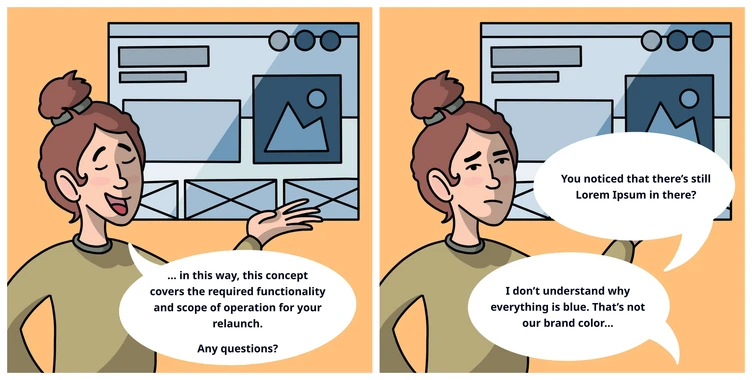A pretty interface does not equal a valid concept
Why “form follows function” is our most important mantra

The human mind is naturally driven by aesthetics. Interface design, therefore, contributes substantially to building a positive user experience. But when it comes to durability and quality, it's what's on the inside that counts.
Although conceptual models are abstract, they let you take a step back and envision how people are going to interact with your product. This distance gives you perspective. Seeing the entire landscape means you can more easily align interactions, relations, transitions, and the functionality of your project. Building an elegant solution underpins a well-made interface.
The secret to a conceptual model is to give stakeholders just enough to get the right idea, but not to dazzle them with looks. You want to provide a schematic representation to explain the flow and function of the sites and elements.

Why do you need a valid concept?
No matter how simple a project might seem in the beginning, getting started with only a vague perception of its framework will only complicate the process. If you invest in a good concept, you will actually save money by eliminating subsequent faults.
Imagine this: You move into a brand new house and need to buy a couch for your living room. You go to the store and think about what color scheme would match the rest of your furniture, which model would seat the perfect number of guests, whether it is comfortable enough for your needs but also for the rest of your household and so on. Once you find the perfect fit, you get it delivered to your home and… it doesn’t fit through the front door. What do you do? Do you settle for an inferior model and accept the loss of quality and unfulfilled needs? Or do you demolish the wall and rebuild a bigger door at a high cost? Neither option sounds compelling.

Wouldn’t the best solution be to choose a house with flexible walls and doors to fit all your needs, no matter how much they will grow or change over time? Flexibility makes your home sustainable and extensible. It’s exactly the same thing with your website. Once you know the goals and features, creating a sitemap and wireframing the outline is the base for your website's infrastructure. These will give you a guide for organizing your website, and a targeted outline for creating content.
A system must first be usable and functional before you can work on making it desirable. Approaching it the other way around will cost you a lot of time and probably your developers' sanity. A solid conceptual strategy ensures a reliable consistency in design and technical implementation as your project evolves.
What makes a valid concept?
This post is not a tutorial on how to map out a concept - it addresses the necessity and benefits of having a conceptual model. First of all, it is important to understand your users' needs so you can implement a positive experience. Always keep the customer in mind: What do they wish for in your product? What is their intention while using it? What do you provide in your product that would make them use it and enjoy it? Whether you create a Persona (or use a different method) to envision your target groups.
Throughout your concept, it is important to follow a well-defined usability strategy. Consistent interaction patterns support the quality of your users' experience. Create a clear user-path and base your structure and functionality around it. Creating an information architecture (IA) and combining it with a customer journey helps to set the base for your sitemap. Validated IA lets your user orient themselves on your site. They’ll know where they are, how they got there, and where they can go next. Technical and visual feedback, intuitive information hierarchies, and clear thematic differentiation between categories will help your website’s flow.
We make you a conceptual offer that you can’t refuse
Form follows function - therefore, invest in a good concept! Thinking ahead and asking questions to understand functionality is key. Create a concept first, communicate it through functionally-descriptive unstyled wireframes and precise elaboration and definitions. Once all the functions, elements, and structures are understood and documented, you can shift the focus to the interface to delight your customer and their end user in the long run.
It’s not too late!
Chat with us about starting your next project with a concept model.
